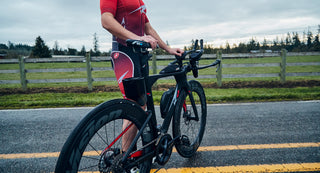As the winter months draw to a close and the weather begins to warm (in Portland, this means many of us are seeing the sun again for the first time this year!!), many of you are eager to get outside again and hit the road. Before setting out on your first long outdoor ride, have you checked to make sure your bike is ready for it?
Winter can be tough on bicycles, arguably especially if you ride indoors. In this blog post, we'll discuss a comprehensive bike maintenance checklist to ensure your ride is safe, smooth, and enjoyable.
-
Clean Your Bike: First thing is first. It's time to clean your bike. If you've been riding outside, your bike may have been in some muddy, grimy conditions. If you're indoors, your sweat likely drips directly onto your bike below you. Really, your bike should be at least wiped down after every ride in these conditions, but we're realists: we know some of you aren't doing this. If you decide to wash down your bike with a hose, pay special care to any bearings -- you don't want strong water pressure (like the jet function) hitting directly into any bearings. A clean bike is a fast bike.
-
Check the Tires (and Sealant): Inspect your tires for any signs of wear -- this is important if you have been using a wheel-on trainer and have spent many months wearing a tire down on the magnetic wheel. This is also why people may opt for a trainer-specific tire, as it's a bit more durable and tougher than a regular road tire. The beginning of the year or race season is a great time to consider getting new tires to makes sure you're safe and less prone to punctures during your outdoor rides. If you're riding tubeless, now is also the time to check your sealant and most likely replace the sealant in your tires. There's nothing worse than having a small puncture not seal simply because the sealant was dried up. (Note: you should be checking and replacing sealant multiple times a year, but it's a great reminder to do it now as well).
-
Inspect the Brakes: Brakes are a critical safety component of your bike, so it's essential to ensure they are in good working condition. Check the brake pads for wear and replace them if they are worn down. Test the brake levers to ensure they engage smoothly and provide sufficient stopping power. If you're using hydraulic brakes, consider going to a bike shop to have your brakes serviced. There are many opinions out there on how often you should perform a brake bleed/service your hydraulic brakes, so we'll present ours: consider having your brakes checked out by a knowledgeable mechanic at least once a year. We prefer to do it during this time as we're prepping for the beginning of outdoor riding and racing. At the end of the day, your brakes are the most important safety feature on your bike - do not skimp on safety.
-
Check your Chain: Check your chain to make sure wear is still good (if you don't have a chain checker, bring it to your local bike shop who will be able to check for you). A worn out chain will have poor shifting, will be less efficient and may also wear out your cassette (aside from the risk of a chain snapping mid-ride!). If your chain is still good, give it a good cleaning with degreaser and re-lubricate it.
-
Check the Drivetrain: Inspect the drivetrain components, including the chain, cassette, and crankset, for wear and tear. Make sure nothing is loose or creaking. If you've been riding inside -- especially in erg mode on a smart trainer -- you may have spent a while in one gear without noticing. Take a moment to ensure that all of your components are good to go.
-
Test the Cables and Shifting: If you've been riding a lot indoors over the winter -- especially on a smart trainer -- there's a chance that you actually haven't been doing much shifting! Make sure you shift through all of your gears to make sure shifting is smooth and and precise. If your bike is relatively new and mechanical shifting, you will want to check your shifting regularly as cable stretch is a thing - you may need to adjust your cable tension to account for this very normal adjustment time. If you're on an electronic shifting bike, check your platform for any updates, and make sure that that the batteries are functioning well and ready for any long rides away from home!
While many of these checks can be done at home, we highly recommend taking your bike to your local trusted shop and/or mechanic for a yearly tune up. They'll know what to check and how to fix anything that needs updating. If you're racing, you may want to consider a standard tune up before races as well.
Remember, a well-maintained bike leads to a more enjoyable and trouble-free riding experience. So, gear up, hit the road, and embrace the joys of spring cycling!



